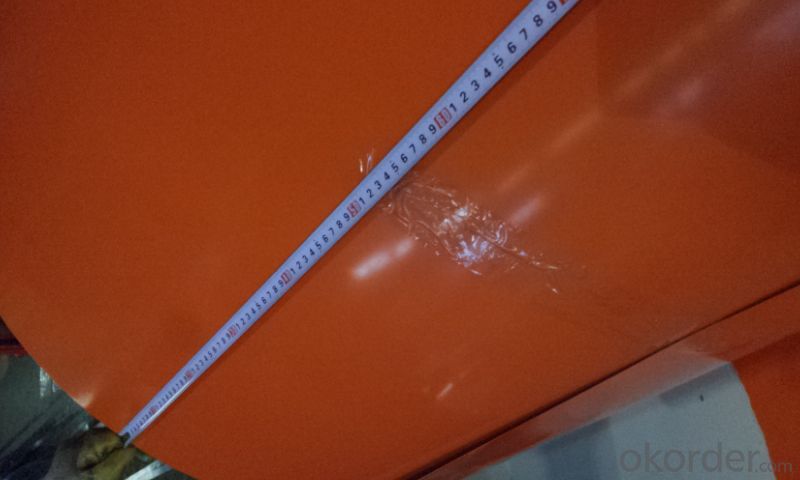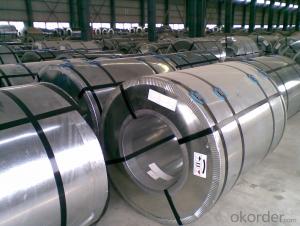prepainted steel coil with 0.20mm
- Loading Port:
- China Main Port
- Payment Terms:
- TT OR LC
- Min Order Qty:
- -
- Supply Capability:
- -
OKorder Service Pledge
OKorder Financial Service
You Might Also Like
prepainted steel coil
Packaging & Delivery
Packaging Detail: seaworthy export package
Delivery Detail: on request
Specifications
1. more than 10 years’ experience on this field
2. advanced equipments
3. competitive price
4. soonest delivery
Product Description :
Packaging & Delivery
Packaging Detail: seaworthy export package
Delivery Detail: on request
Specifications
1. more than 10 years’ experience on this field
2. advanced equipments
3. competitive price
4. soonest delivery
Product Description :
Commodity
prepaited galvanized steel coil
Technical Standard:JIS 3312
Types:Commercial / Drawing / Deep Drawing / Structural quality
Width: 900mm/1000mm/1219mm/1200mm/1220mm/1250mm
Thickness: 0.2mm
Type of coating: galvanized
Zinc coating: Z40-275g/m2,Z40-Z450g/m2
color :RAL NO
ID coil: 508mm or 610mm
Coil weight: 3-10/MT per coil
Package:Properly packed for ocean freight exportation in 20''container
Application::home appliances, constructions, building, machineries
Our Advantages :
1. Expertise:
More than 10 years of manufacture: we know how to properly handle every step of production.
2. Competitive price:
We can offer competitive prices to our customers.
3. Accuracy:
We have excellent technicians and leaders, which can ensure our products are exactly what you want.
4. Materials:
All galvanized steel coils are made of high-quality raw materials.
5. Certificate:
Our products are certified by ISO9001.
6. Productivity:
We have large-scales of production lines,, which can guarantee all your orders will be finished in earliest time.
Hr CGL Technical Process:
Coil loading-> uncoiling-> cutting-> welding-> entry accumulator-> Heating and deoxidization-> galvanizing-> air cooling->water quenching-> air dryer-> tension leveler-> Passivation->air dryer->exit accumulator-> oiling-> cutting-> recoiling->coil unloading-> packing
The furnace heating style: improved Sendzimir heating technology
Hourly output: max.76.3t/h
Process after coating: tension leveling, Passivation or oiling
Our Service
Our quality
Test Equipments of Prepainted Galvanized Steel Coil : Salt-spray tester; Atomic absorption spectrophotometer; Rockwell typer hardness tester; Tensile test machine; Metrohm titration; Laboratory Bend test machine.
Our packing
Properly packed for ocean freight exportation in 20''container, galvanized metal fluted rings on inner and outer edges, galvanized metal & waterproof paper wall protection disk, galvanized metal & waterproof paper around circumference.
R&D department
R&D department concentrates on researching and developing reliable products with best quality. The quality department test and control every process of production to guarantee the best quality of product
- Q: I asked a question last week about stainless steel and got some great answers. I combed all over the internet to try to figure this one out but could not find anything. What resists bending better: chrome vanadium steel (i.e. a steel commonly used to make tools) or stainless steel 304. My guess would be the chrome vanadium alloy but thats just a guess. Which on resist's bending better and by how much (#'s please :-)). Also, if anyone knows if chrome vanadium steel is cheaper than stainless steel 304 that would be awesome? I can't find a price per pound on chrome vanadium steel anywhere! Please help. Thanks in advance-Josh
- Steel Bending Strength
- Q: How are steel coils used in the production of metal staircases?
- Steel coils are an essential component in the production of metal staircases. These coils, typically made of high-quality carbon steel, are first uncoiled and then go through a series of manufacturing processes to shape them into the required stair components. The first step in the production process involves cutting the steel coils into the desired lengths using specialized machinery. This allows for customized sizing to fit the specific staircase design. Once cut, the coils are then formed into various shapes and profiles, such as stringers, treads, and risers, through processes like bending, rolling, and stamping. The use of steel coils provides several advantages in the production of metal staircases. Firstly, steel is known for its strength and durability, making it an ideal material choice for staircases that need to withstand heavy loads and frequent use. The flexibility of steel coils allows for the creation of intricate and complex staircase designs, providing architects and designers with a wide range of options. Furthermore, steel coils can be coated or finished in various ways to enhance their appearance and protect them from corrosion. This can include painting, powder coating, or applying a protective layer such as galvanization. These finishes not only add aesthetic value to the metal staircases but also increase their longevity and resistance to wear and tear. In summary, steel coils are integral to the production of metal staircases as they provide the raw material that is shaped and formed into the necessary components. Their strength, flexibility, and ability to be finished in different ways make steel coils a versatile and reliable choice for manufacturing durable and visually appealing staircases.
- Q: How are steel coils inspected for elongation using elongation testers?
- Elongation testers are utilized to inspect steel coils for elongation, following a specific procedure. Initially, a representative sample is extracted from the steel coil, which is then prepared for testing by cutting it into a specific size and shape. Typically, the sample takes the form of a flat strip. Next, the prepared sample is inserted into the elongation tester, which comprises two clamps. One end of the sample is securely held in one clamp, while the other end is held in the other clamp. These clamps are designed to prevent any slippage during the testing process. Once the sample is securely clamped, the elongation tester applies a gradually increasing tensile force to the sample. Consequently, the sample elongates. During this elongation, the tester measures the change in length using a precision measuring instrument, like a strain gauge or an extensometer. The elongation tester records the original length of the sample before the test and continuously measures the length as the force is applied. To calculate the elongation percentage, the original length is subtracted from the final length of the sample, which is then divided by the original length. The obtained elongation value is then compared to the elongation requirements specified by industry standards or customer specifications. If the elongation falls within the acceptable range, the steel coil is considered to have passed the elongation test. On the other hand, if the elongation value exceeds the allowable limits, the steel coil might be rejected or undergo further investigation to determine the cause of elongation. Overall, the process of inspecting steel coils for elongation using elongation testers involves sampling, secure clamping, application of tensile force, length measurement, and elongation percentage calculation. This ensures that the steel coils meet the desired standards and requirements, guaranteeing their quality and mechanical properties.
- Q: What are the dimensions of steel coils used in bridge construction?
- The dimensions of steel coils used in bridge construction can vary depending on the specific requirements of the bridge project. However, generally speaking, the dimensions of steel coils used in bridge construction typically range from 0.5 inches to 1 inch in thickness and 36 inches to 72 inches in width. The length of the coils can vary as well, but is commonly around 20 to 40 feet. These dimensions allow for the fabrication of various structural components such as beams, columns, and plates that are essential for the construction of bridges. It is important to note that the dimensions may vary based on the specific design and engineering specifications of the bridge project, as well as the type and load capacity of the bridge being constructed.
- Q: What are the dimensions of steel coils used in the construction equipment industry?
- The dimensions of steel coils utilized in the construction equipment industry may differ depending on the particular application and requirements at hand. Nevertheless, there exist standard dimensions that are commonly employed. Typically, steel coils employed in the construction equipment industry possess a width ranging from 600mm to 2000mm. The thickness of these coils can vary from 0.5mm to 25mm or potentially higher, contingent upon the intended purpose and structural prerequisites. The weight of steel coils utilized in the construction equipment industry can differ significantly, spanning from a few hundred kilograms to numerous tonnes. The weight is typically determined by the dimensions and thickness of the coil, as well as the specific grade and type of steel employed. It is crucial to note that these dimensions are not fixed and can be tailored to cater to the specific needs of the construction equipment industry. Manufacturers and suppliers have the capability to provide steel coils in various dimensions to fulfill the precise requirements of construction equipment manufacturers and contractors.
- Q: I'm trying to buy a Survival,tactical knife but don't know what steel is better
- You pay your money and take your choice. High carbon non-stainless steels are easier to sharpen and hold their cutting edge longer than stainless. Stainless steels generally are rust resistant, not rust-proof. However, there are more than 40 types of steels being used for knife-making. Probably the best in the stainless range are the American Hi-performance Stainless Steels. These are graded as; CPM440V, CPM420V, CPM10V, CPM3V and 154-CM. Incidentally, nearly all knife steels contain carbon in varying amounts. The only one that I am aware of that does not contain any carbon is Sandvic12C-27.
- Q: hey therejust wondering about changing nylon strings to steel strings...i have an acoustic guitar and it has nylon strings, but i was thinking about switching to steel strings, as i think it sounds better.this might sound really stupid... but is that possible? i mean they call it a steel stringed GUITAR and nylon stringed GUITAR, so if i wanted to switch would i have to get a whole new guitar? please help, im reaaally confused!thanks
- Steel strings can't go on nylon stringed guitars. So, yes, you have to buy a new guitar.
- Q: How are steel coils inspected for surface defects?
- Steel coils are inspected for surface defects using various methods such as visual inspection, magnetic particle inspection, eddy current testing, and ultrasonic testing. These techniques allow for a thorough examination of the coil's surface, identifying any cracks, scratches, dents, or other imperfections that may affect the quality of the steel.
- Q: How are steel coils used in the production of steel clamps?
- Steel coils are used in the production of steel clamps as they provide a continuous supply of high-quality steel material. These coils are unwound and processed through various manufacturing steps, such as cutting, shaping, and forming, to create the desired shape and dimensions of the steel clamps.
- Q: I want to get one of these knives but I am having trouble deciding which is the best overall knife??ThanksSOG Trident tigerSOG Vulcan TantoSOG Bi-Polar (Serrated)Cold Steel ScimitarCold Steel Recon 1
- Those are all excellent quality knives so if the style of knife that you want is available from several makers it comes down to personal preference. I would go with SOG myself but the others are real good too.
Send your message to us
prepainted steel coil with 0.20mm
- Loading Port:
- China Main Port
- Payment Terms:
- TT OR LC
- Min Order Qty:
- -
- Supply Capability:
- -
OKorder Service Pledge
OKorder Financial Service
Similar products
Hot products
Hot Searches
Related keywords






























